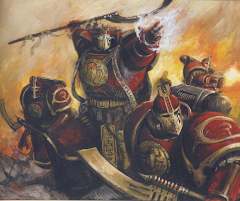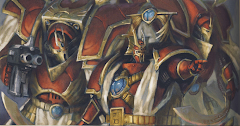Warhammer 40,000 5th Edition has been around for just about three years now, and the more I play the more I notice that there are certain mechanics in the system that are poorly implemented, poorly designed or both. To the credit of Games Workshop there are some situations where these mechanics are hold-overs from old editions while in others they are victims of an older codex in a new edition.
So what makes a bad mechanic? 40K relies heavily on its story and modeling aspects for player enjoyment so the primary mark of a bad mechanic in its system is when the desirable outcome of a situation goes against what feels might be the right militarily sound and intuition-rooted decision to make.
Stubborn. This universal special rule (USR for short) works poorly in so many situations for so many armies that I usually dismiss it. In 5th Edition, most of the time that your units are on the losing end of a close combat, it's because an opponent's specialized close combat unit has charged your unit that isn't good in that theater of combat. While the intuitive notion of 'hold at all costs!' comes to mind, the most desirable tactical outcome here is that your weaker unit will fall back away from the combat or be wiped out by it. This leaves the opponent's unit hanging in the wind, waiting for your guns to weaken and possibly destroy it. It's simply counter-intuitive that you would desire the destruction of one of your units.
The first time Stubborn showed up in 5th Edition was in Codex: Space Marines. Both Lysander and Kantor make their armies stubborn. In an army like Space Marines the majority of your units consist of ten or fewer models. Additionally, the natural tendencies of players building these armies will maximize their units so that their are either good in close combat or good at ranged combat. In some cases they are mediocre at both, but only out of necessity (Tactical and Scout squads). An unit that's good at close combat but is also Stubborn has little use for its USR. This means that you've paid too many points for that unit because it's not able to maximize its potential the same way it might if you had paid the points for another USR. For instance, an Assault squad in a Lysander-based SM force isn't as good as an Assault squad in a Shrike-based force. Since this maxim would apply to just about any unit that you might include in a Lysander-based force, you have to conclude that Stubborn is actually a drawback because it doesn't do anything for you unless you're on the losing end of a close combat. Any good 40K general will eventually realize that they shouldn't plan their tactics based on a strategy that relies on being on the losing side. In other words, you don't want to plan on losing a close combat just to use your Stubborn ability to stay in that losing combat. Ok, so there are a couple situations where it MIGHT be beneficial to hold your unit in a losing combat, but those situations are so few and far between (not to mention that they lead to unpredictable outcomes) that they simply aren't worth planning around.
Stubborn is utilized correctly in Codex: Imperial Guard. It's possibly to take large units of infantry (40+) that can be highly effective in close combat, even though they are highly likely to lose every round. They can win combat eventually, but they are going to do it through a gradual and grinding process of attrition. Then there are the highly specialized Penal Legion squads; these are cheap, disposable units that will stall the advance of an enemy that rates as mediocre in close combat. Finally, the ability of certain characters to provide Stubborn to units they don't have to join is invaluable since there is no chance of that baby being thrown away with the bathwater (you don't lose the sacrificial speed bump AND its supporting character in one fell swoop).
It seems that it may not be the actual Stubborn mechanic that is problematic, but merely its codex-level implementation. So if we could go in and surgically modify existing codices, what might be a few examples of a better place for the rule? Part of the answer lies in what I feel are the flaws of the Fearless mechanic.
See my next post about Fearless.
Sunday, June 5, 2011
Subscribe to:
Post Comments (Atom)






























Hello Warhammer 40k it's Brian (I was at AI last night Tuesday June 14 when you were showing the Tyranid player Army Builder). Interesting article! I've long had mixed feelings about Stubborn. I've long had even more mixed feelings about Combat Tactics. Combat Tactics is great if your opponent kills enough of your guys during his shooting phase. It's mediocre in combat. You might get away, you might not. Against opponents with initiative higher than 4, your chances decrease quite a bit. A savvy opponent that really wants to get his uber close combat unit into combat with your Space Marines probably isn't going to shoot you before charging.
ReplyDeleteAs for Stubborn I agree that it's not the best USR to have. Both it and Combat Tactics depend on something bad happening to you in order to use them. And your point about planning tactics around being on the losing side is well received, I concur wholeheartedly. In the interest of spirited debate, or more selfishly, finding a use for that Lysander model I so painstakingly pinned, glued, primed and painted I will attempt to find "good" (or at least semi-decent) uses for Stubborn, and post some on my blog soon.
I seem to recall reading something a long time ago that dealt with the topic of 'Napoleon tactics.' It referred to how Napoleon had strategies that, while geared towards winning, didn't fully take advantage of their potential (or something to that effect). it's like, if you're not keeping 'victory' as your foremost goal, then you're opening yourself up for losing.
ReplyDelete